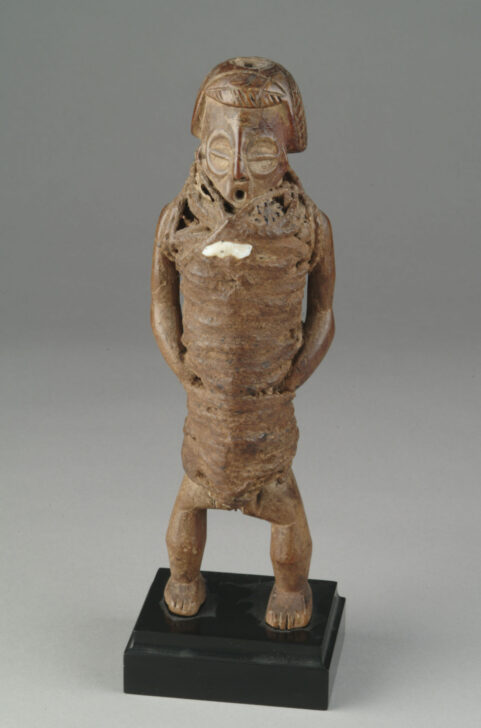Male Figure
Bembe

Description
Subject Matter:
This anthropomorphic figure is the female counterpart of a pair of carved, wooden sculptures attributed to the Bembe, who today live in the Democratic Republic of the Congo. Belonging to a rare, ancient pre-Bembe style and carved by the same craftsman, there are a few theories as to who this couple represents. First, these male and female figures may symbolize the clan’s founding ancestral couple. As the primordial progenitors, their powerful spirits continue to watch over their descendants in the afterlife. If the ancestral spirits are neglected, misfortune may vengefully strike the living, and, if they are revered and paid dutiful homage, then the lineage is assured protection, prosperity, and progeny.
Second, it is also possible that this couple may have been used by a milindi ya batee, or a Bembe diviner. Since figural representations embody spirits, a diviner could have used these figures to hex an actual couple by specially crafting a mixture of “medicines,” in fact, poisons, to generate an illness. This is evidenced by the fact that medicinal substances (derived from animal and vegetal ingredients of symbolic rather than pharmacological value) have been meticulously tied to the male’s figure and, at one point, probably the female’s too. Additionally, both figures have cavities in the fontanelle region of their crowns; this is where animal horns carrying more medicine would have been inserted. The expressions of pain revealed in the figures’ shut eyes and agape mouths suggest the intention to inflict harm.
Yet, another theory is possible. A milindi ya banya, or healer could have confiscated the figures from another diviner and proceeded to deactivate the malicious spell from the victims. In order to “disenchant” and cure the patients, the healer will use the same figures employed in the original sorcery in order to exorcise the spirit responsible for producing the malady.
Reference:
Maurer, Evan M. and Niangi Batulukisi. Spirits Embodied: Art of the Congo, Selections from the Helmut F. Stern Collection. Minneapolis: The Minneapolis Institute of Arts, 1999.
Physical Description:
This carved wooden figure depicts a standing male, and is one of a pair that includes a female figure also carved by the same hand. According to noted art historian Niangi Batulukisi, these two figures deviate from the classical Bembe style and are “an extreme rarity” due to the fact that they are likely connected to an ancient pre-Bembe style.
The male figure’s trunk is disproportionately long, while the legs are slightly flexed at the knees. His facial features includes closed eyes set in round, ocular cavities and a perfectly rounded, open mouth. The hairstyle bears geometric motifs. Most striking, however, is that medicinal substances have been tied around the male’s entire torso--indeed from his neck to his pelvis--by tightly-wound, resin-covered strings. Moreover, a hole appears on the crown of his head, likely intended for the placement of an animal horn containing even more medicinal ingredients. A small sliver of a white shell appears across the figure’s chest. Traces of tukula powder can be found upon the figure’s surface.
Usage Rights:
If you are interested in using an image for a publication, please visit https://umma.umich.edu/request-image/ for more information and to fill out the online Image Rights and Reproductions Request Form.